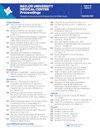脊髓可逆性脑血管收缩综合征。
Q3 Medicine
Baylor University Medical Center Proceedings
Pub Date : 2025-03-10
eCollection Date: 2025-01-01
DOI:10.1080/08998280.2025.2473815
引用次数: 0
摘要
我们报告了一名19岁的女性,她出现了可逆性脑血管收缩综合征(RCVS),主要是后循环梗死,包括高颈脊髓梗死。RCVS被认为是大脑的一种短暂性血管痉挛状态,据我们所知,以前没有描述过会影响脊髓。本文章由计算机程序翻译,如有差异,请以英文原文为准。
Spinal cord reversible cerebral vasoconstriction syndrome.
We present the case of a 19-year-old woman who developed reversible cerebral vasoconstriction syndrome (RCVS) with primarily posterior circulation infarcts, including a high cervical spinal cord infarct. RCVS is thought to be a transient vasospastic condition of the brain and, to our knowledge, has not been previously described to affect the spinal cord.
求助全文
通过发布文献求助,成功后即可免费获取论文全文。
去求助
来源期刊

Baylor University Medical Center Proceedings
Medicine-Medicine (all)
CiteScore
1.30
自引率
0.00%
发文量
245
 求助内容:
求助内容: 应助结果提醒方式:
应助结果提醒方式:


